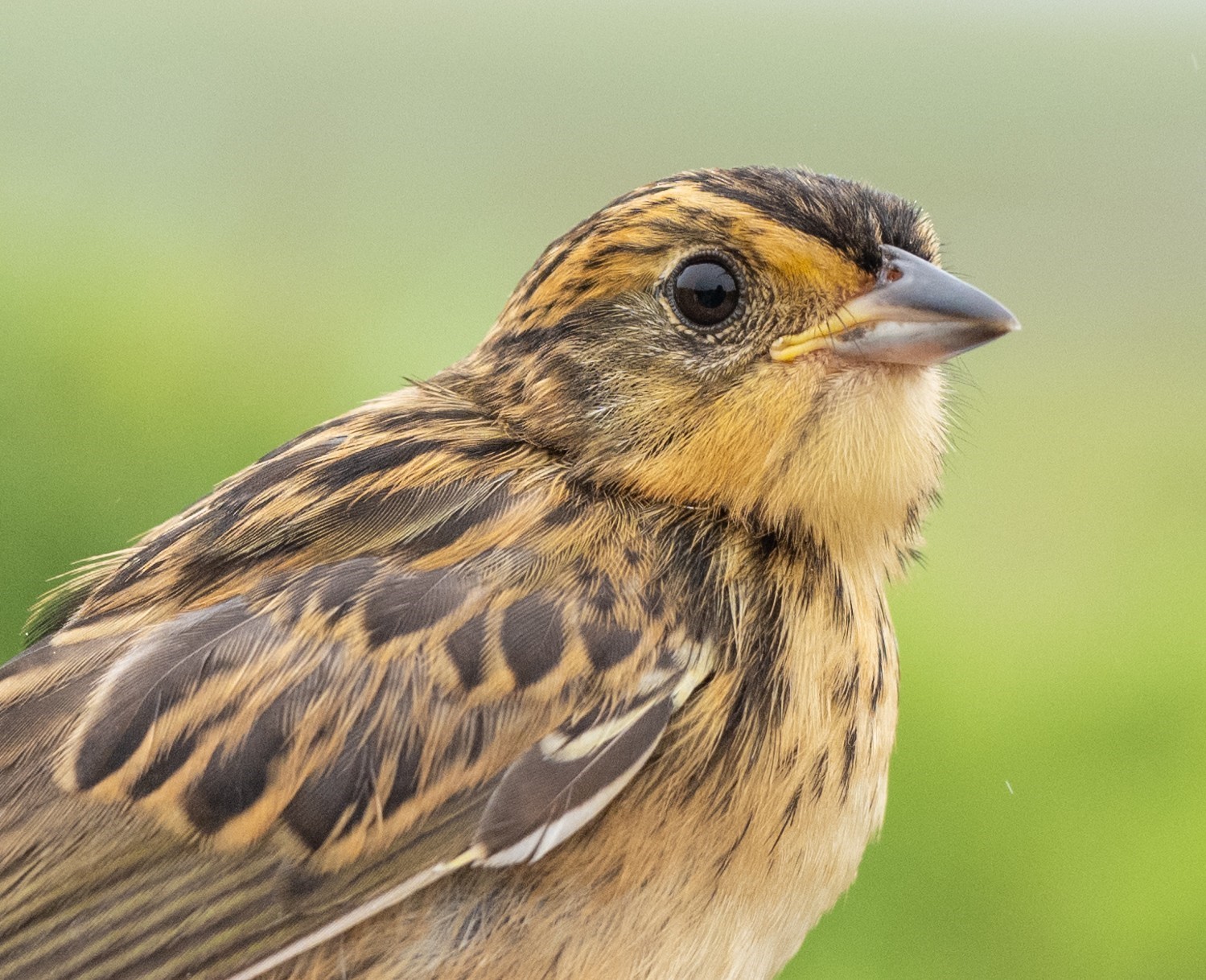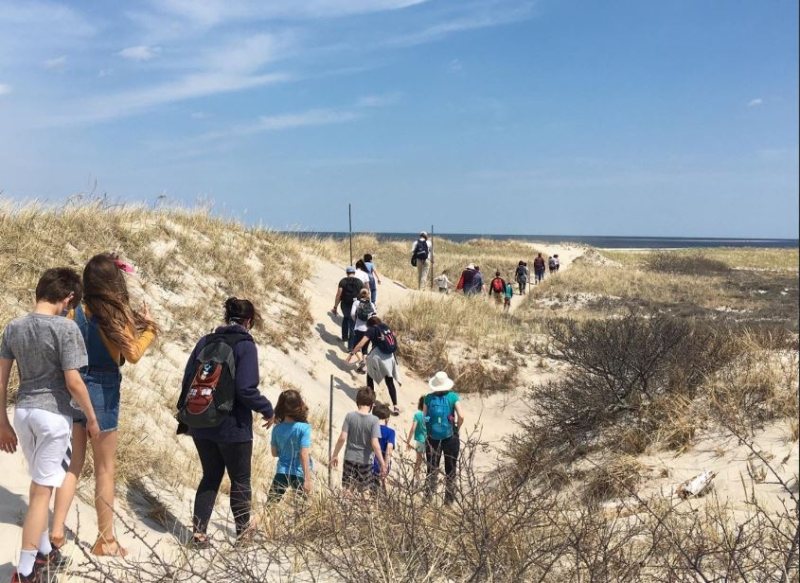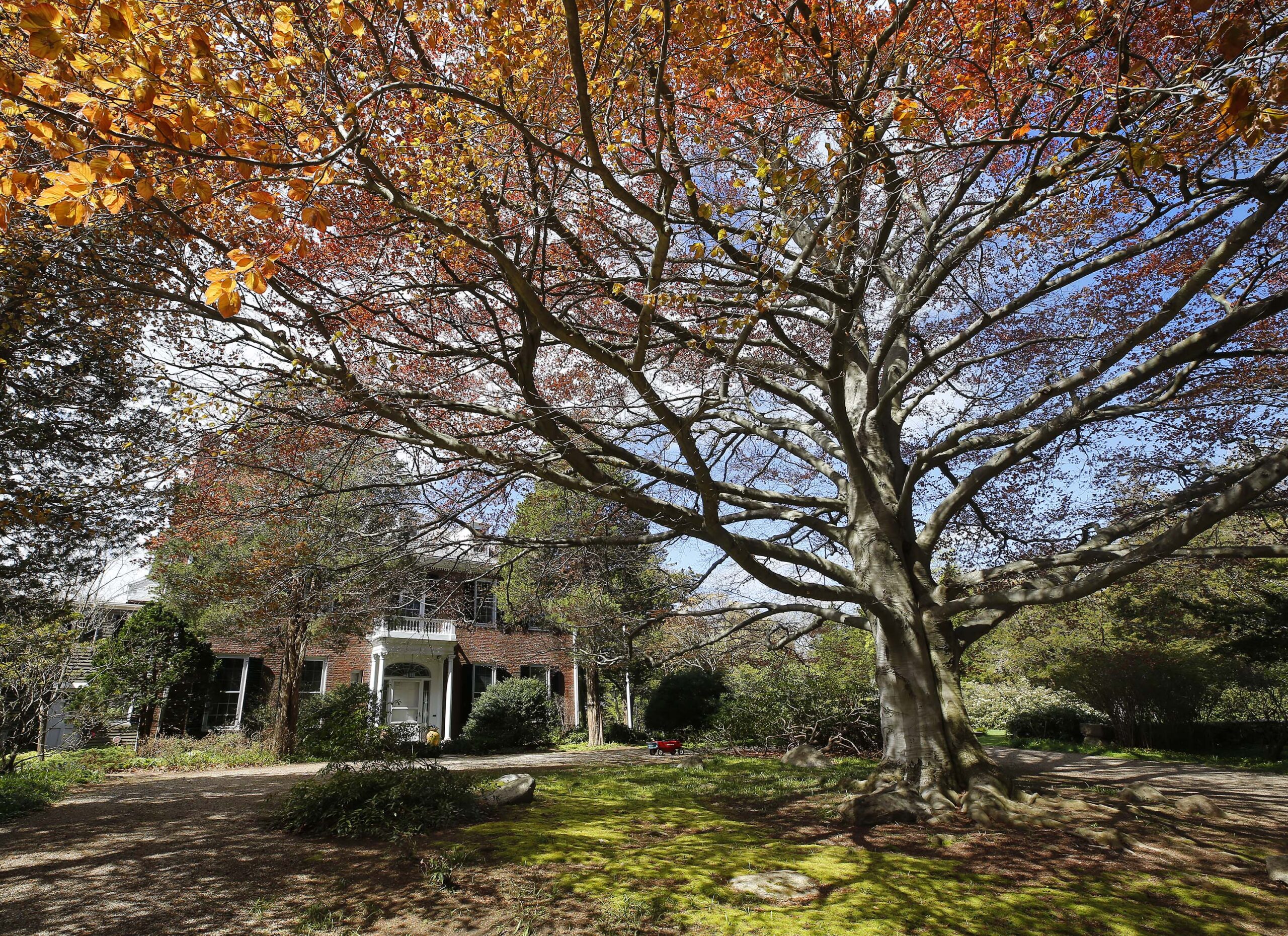Since the late 1990s, conservationists have been outfitting American Oystercatchers along the Atlantic and Gulf coasts with colorful leg bands to help track their movements and better understand their life histories. Each bird receives a small metal band on one of its lower legs and brightly colored plastic bands with unique alphanumeric codes on its upper legs.
The metal band is small, lightweight, and stamped with a unique number, issued by the U.S. Geological Survey’s Bird Banding Laboratory—a federal agency that oversees bird banding. It functions like a government ID. However, the code is too small to read unless the bird is in hand, so for field identification we rely on the larger, plastic bands, which are designed to be readable from a distance using binoculars or spotting scopes.
Each bird’s plastic band combination is unique, allowing researchers, volunteers, birders, and even casual beachgoers to identify individuals in the field. So next time you’re out on the shore and spot an oystercatcher, take a closer look at its legs. If you can read the code, you can contribute to science by reporting the sighting to the American Oystercatcher Working Group Banding & Re-sighting – American Oystercatcher Working Group.
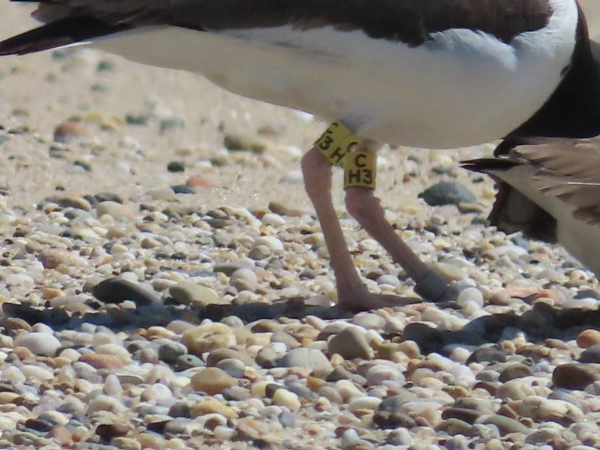
Example of a plastic field-readable band. Birds banded in MA typically have yellow bands.
Banding allows us to track individual birds’ survival, reproductive success, fine-scale movements on breeding or overwintering grounds, and large-scale migratory movements. These types of data help us understand the life of the oystercatcher, which allows for the development of more effective and better focused conservation efforts. These efforts are becoming more and more important as this species faces increasing threats from climate change, habitat loss, predators, and human disturbance.
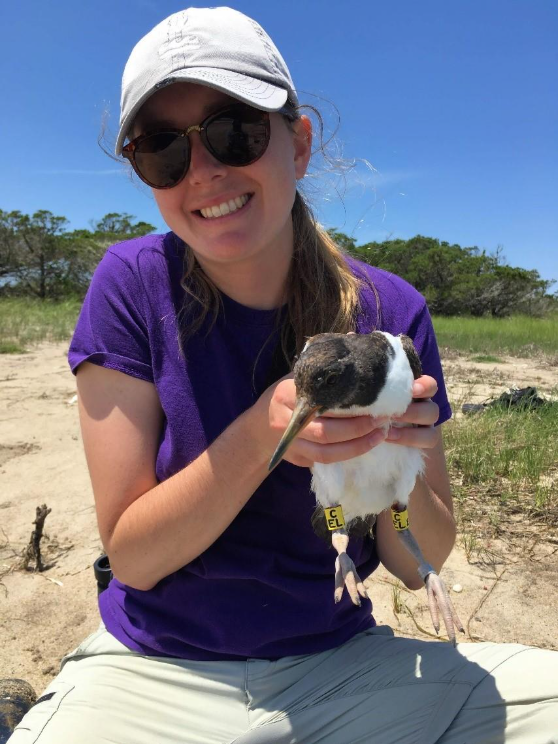
Coastal Ecologist Shea Fee assists the Nantucket Conservation Foundation band chicks on Coatue in 2019. All banding is done under appropriate permits.
The islands of Nantucket and Martha’s Vineyard have the highest densities of American oystercatchers in the state. As of this summer the shorelines of Massachusetts host 283 breeding pairs. Together, the islands support over 40% of the state’s total breeding population. Below you will get to know some if the amazing banded birds that nest on the Trustees’ island properties.
Nantucket
Oystercatcher banding on Nantucket began in 2005, led by then-PhD candidate Sean Murphy and his advisor, Dr. Richard Veit. Their research aimed to better understand the species’ breeding dynamics and document its northward range expansion. Banding efforts expanded on island in 2006 when additional local partners were brought on including the late Edie Ray and the Nantucket Conservation Foundation (NCF). After Sean’s field work wrapped up, banding efforts continued thanks to Edie and the dedicated team at NCF. Their work laid the foundation for what has become a long-running banding program that continues to this day. In total, 386 birds have been banded on Nantucket since 2005, including on the Trustees Coskata- Coatue Wildlife Refuge.
Meet Coskata-Coatue’s Oystercatchers
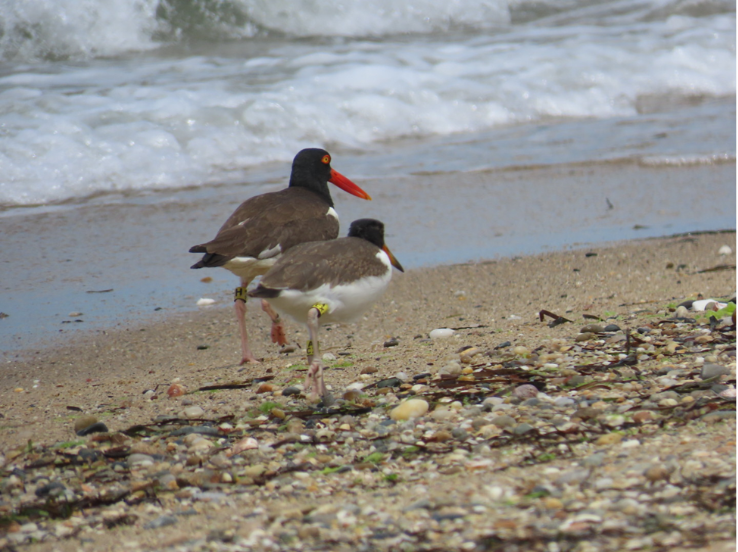
H2 with its 2025 fledgling, yellow ACX.
Yellow H2- Is our oldest bird and was part of the original banding cohort. It was banded as a breeding adult on Tuckernuck Island in 2006, making it at least 23 years old (it takes about 4 years for this species to reach sexual maturity). It nested on Tuckernuck for the next 2 years then was not recorded again during the breeding season for the following six years. It was first recorded exploring the Coskata-Coatue Wildlife Refuge in 2015 but nesting was not confirmed until 2017. Tragically, H2 lost its long-time mate of 5 years yellow R9 in 2020 to a peregrine falcon. However, H2 was quickly able to find a new unbanded mate. In 2023, it paired up with new mate, yellow CAF and they have remained together since. This year, H2 once again proved its excellent parenting abilities, successfully fledging one chick with CAF! H2 will be departing shortly for its regular wintering grounds in Levy, FL, preparing to migrate approximately 1,500 miles.
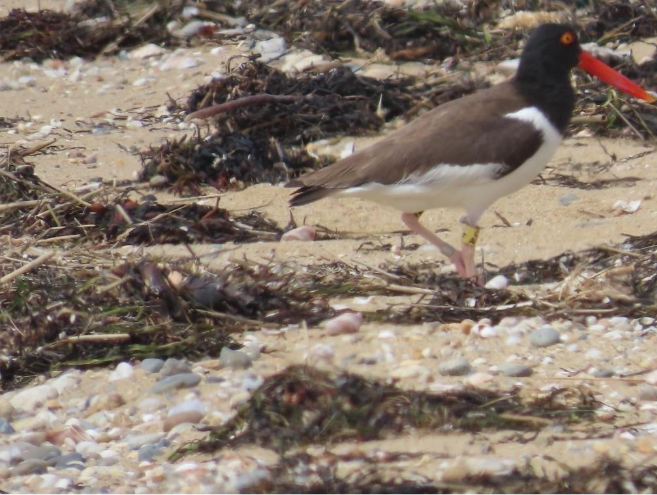
Yellow CAF- Banded as a chick on Coatue Wildlife Refuge, Nantucket along with its sibling in 2018, this bird is 7 years old. It first returned to Coatue in 2022 but did not appear to nest. Breeding was first confirmed in 2023 with yellow H2. Together they were able to fledge 1 chick this year. This chick was banded by staff from the Nantucket Conservation Foundation and the Trustees’ Shorebird Technician (yellow ACX seen above). Like its mate, this bird overwinters approximately 1,500 miles south, in Levy, FL.
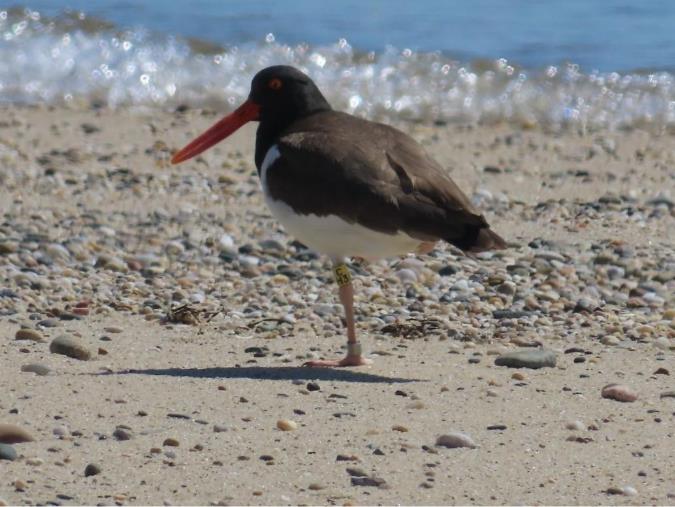
Yellow CH3- Banded as a chick on Coskata– Coatue with its three siblings in June of 2020, CH3 has retuned each year as an immature, non-breeding bird. Its first attempt at nesting occurred last year, not far from where it hatched. This year, CH3 had 2 nesting attempts with its unbanded mate. The first was lost in a storm and the second hatched but all chicks were lost before they were able to fly. This bird spends its winters on the Gulf Coast of FL near Cedar Key.
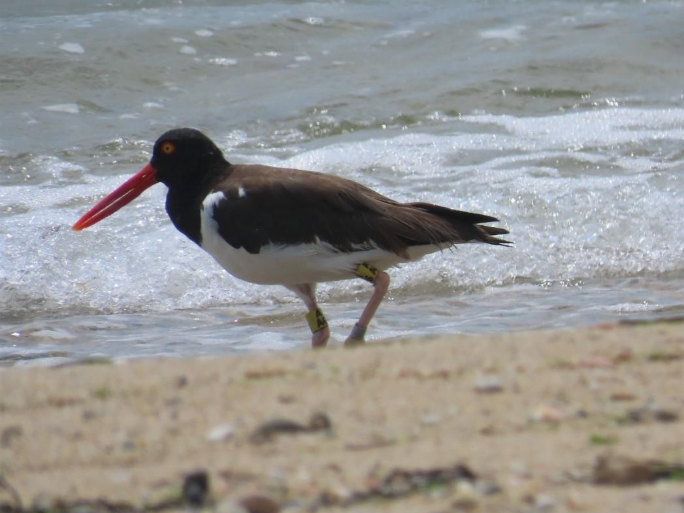
Yellow AA6- Another one of our senior oystercatchers, AA6 was banded on Coskata-Coatue as a breeding adult in 2014, making it at least 15 years old. It has returned to the refuge to raise a family each year since. AA6 winters in Citrus, FL on the gulf coast, migrating about 1300 miles one-way. Unfortunately, AA6 and its unbanded mate struggled with egg viability this year and were unable to hatch chicks.
Yellow CAX- Banded as a chick on Coskata-Coatue in 2018 making it 7 years old. It returned as a juvenile 2020 and was first confirmed breeding in 2022 with an unbanded mate. This season, they were able to fledge one chick. This bird also overwinters near Levey, FL.
Yellow HAY- 2025 marks the first ever nesting season for this young bird. Banded as a chick on Coatue in 2022, HAY found an unbanded mate and hatched one chick. Unfortunately, they were not able to fledge this chick but not a bad first attempt for a new parent! HAY flies1000 miles to migrate to Isle of Palms, SC in the winter.
Yellow CEJ- Banded as a chick in 2019 on Coatue, CEJ is 6 years old. With its unbanded mate, CEJ was able to fledge 2 chicks this year! This bird overwinters on either Assateague Island, MD or Beaufort, SC.
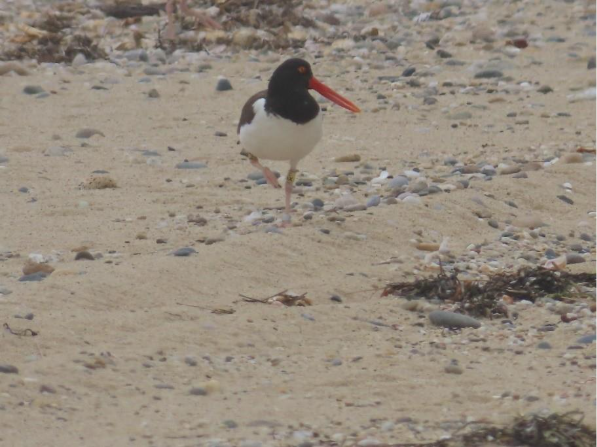
Yellow CH2- Now 5 years old, CH2 was banded as a chick on Coskata-Coatue along with its siblings in 2020. 2025 marks its second breeding year which was unfortunately, unsuccessful. Its first and only nesting attempt was swept away in a storm surge during a spring nor’easter. In the fall it will migrate about 1,000 miles to its wintering grounds in Charleston, SC.
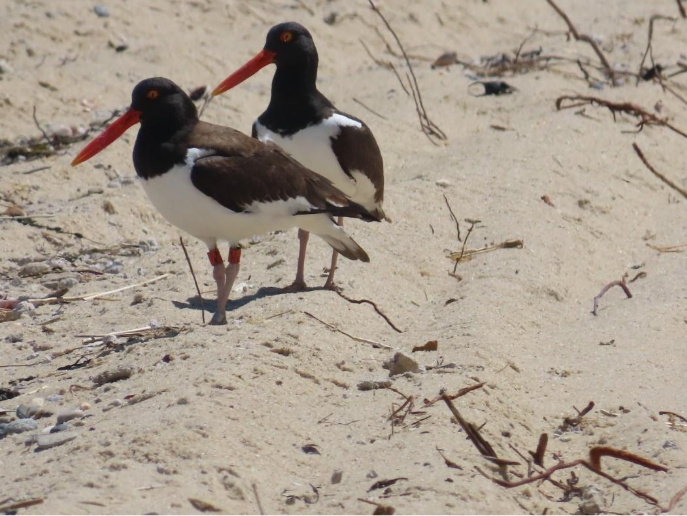
Orange NET- She was banded as a chick in 2020 on Long Island, making her 5 years old. This is our only banded bird that does not have Nantucket origins. She made her first recoded foray into Massachusetts when she was resighted in June 2023 in Provincetown. She was first spotted on Coskata-Coatue in 2024 with an unbanded male. They went through the motions of pair bonding and nesting but she did not produce eggs. Typically, takes about 4 years for an oystercatcher to reach full maturity so it is common for young birds to practice nesting before they are physically mature enough to breed. She was spotted again this summer but nesting was not confirmed. Maybe next year she will have her first official nest! She overwinters in Cedar Key FL, traveling about 1,500 miles each way during spring and fall migration.
Meet Cape Poge and Leland Beach’s Oystercatchers
Oystercatcher banding on the Vineyard began in 2006 when Sean Murphy made 2 trips to the island to band chicks and adults as part of his study. After those initial efforts, banding was conducted sporadically. Most recently in 2024, the late Shilo Schulte of Manomet Conservation Sciences and the team at BiodiversityWorks were able to band several individuals at Edgartown Great Pond and Squibnocket. Despite limited banding efforts on island, many of our oystercatcher that nest on Cape Poge Wildlife Refuge and Leland Beach are banded. Unsurprisingly, the majority of these birds are Nantucket natives.
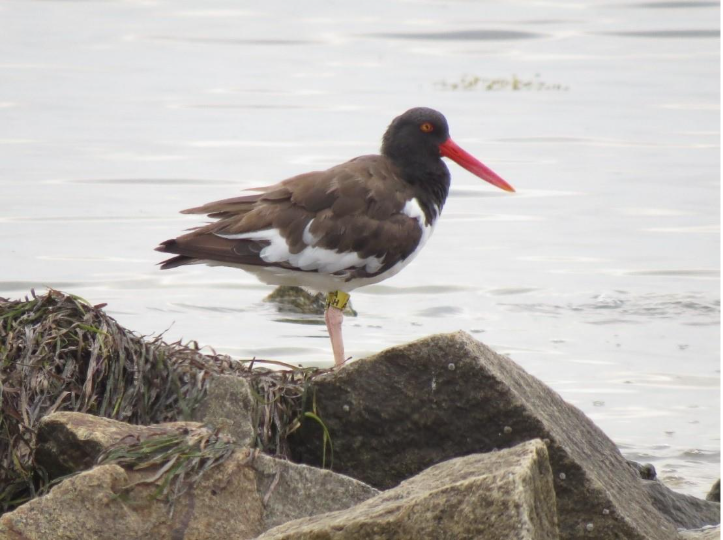
Photo by Francesca Zern
Yellow AAH- Now at 9 years of age, AA6 was banded as a chick on Eel Point, Nantucket in 2014. It currently nests on Cape Poge with its unbanded mate. The band code AAH perfectly describes my sentiments about this bird’s 2025 breeding season (aahhh!). It had a rough go of it, re-nesting four times. Three nest attempts were thwarted by skunks– a notorious egg predator- and one attempt was lost to overwash during a storm. Despite their resilience and persistence, this pair was unable to hatch chicks. This bird winters in Cedar Key, FL, flying an estimated 1,300 miles during each migration.
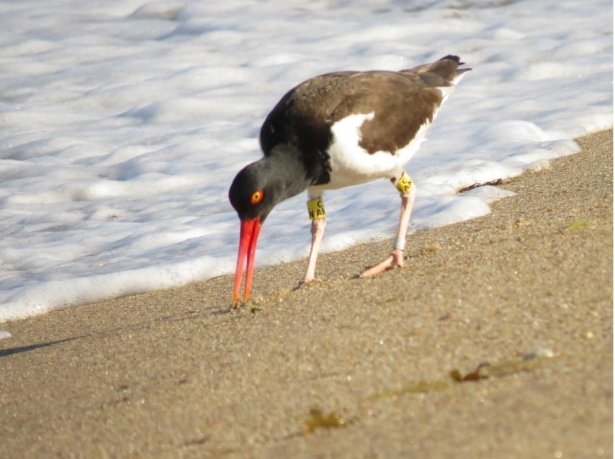
Yellow CAN- Banded as a chick on Coatue, Nantucket in 2018, CAN is 5 years old. It made a quick stop in Rhode Island in July 2020 when it was resighted at Napatree Point. It was first seen on Cape Poge as a juvenile non-breeder in June 2022. It has been an annual breeder on Cape Poge since 2023 with its unbanded mate. Their one nesting attempt this season produced their first ever fledgling. As of now, this bird has not been spotted outside of its nesting grounds, leaving its preferred wintering location a mystery.
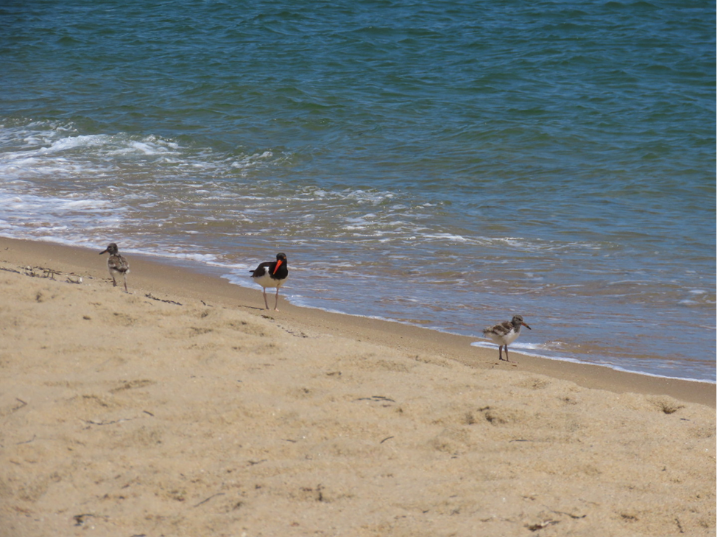
CT’s 2 chicks and its unbanded mate this year.
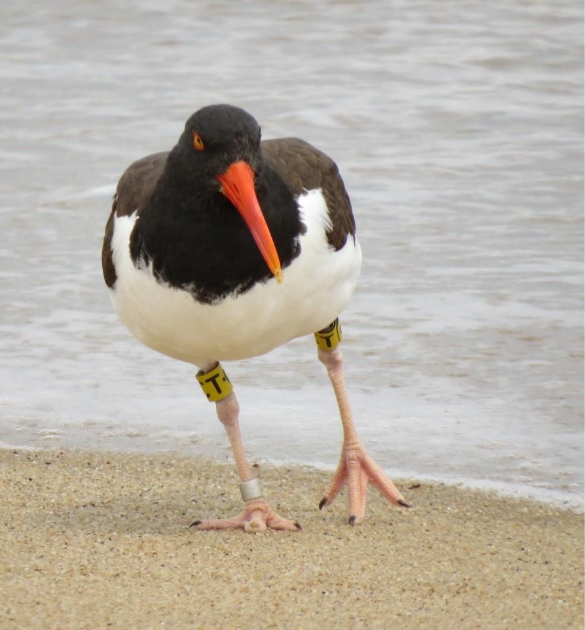
Photo by Francesca Zern
Yellow CT- As one of our oldest birds, CT was banded as a breeding adult in 2010 on Cape Poge, making it at least 17 years old. It has nested in Edgartown and various places on Chappy but returned to its birth place on Cape Poge to nest in 2023. This season, it lost its first nest to skunk predation but was able to fledge 2 chicks with its unbanded mate! It winters in Liberty, GA, migrating 950 miles each way.
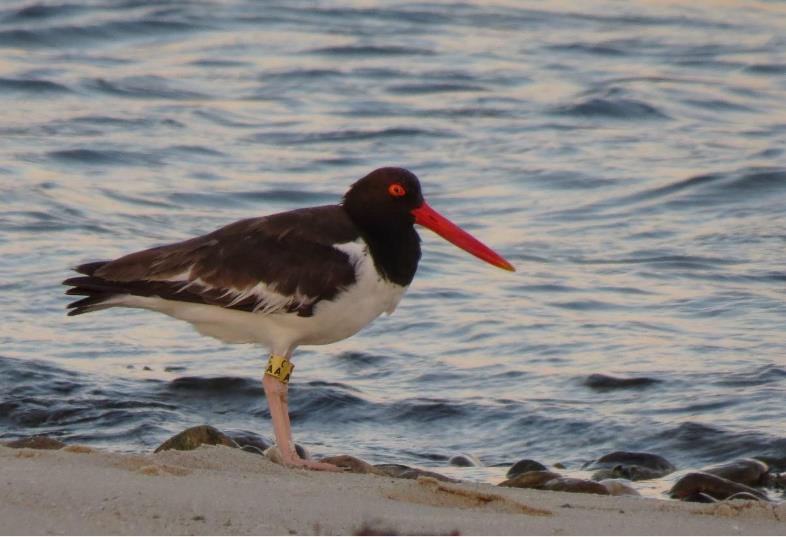
Photo by Francesca Zern
Yellow CAA- At 7 years old, CAA was banded as a chick in 2018 on Nantucket. This is its third season nesting on Cape Poge with its unbanded mate. This year, they were able to fledge 1 chick. Every fall it migrates over 1,300 miles to overwinter in Cedar Key, FL.
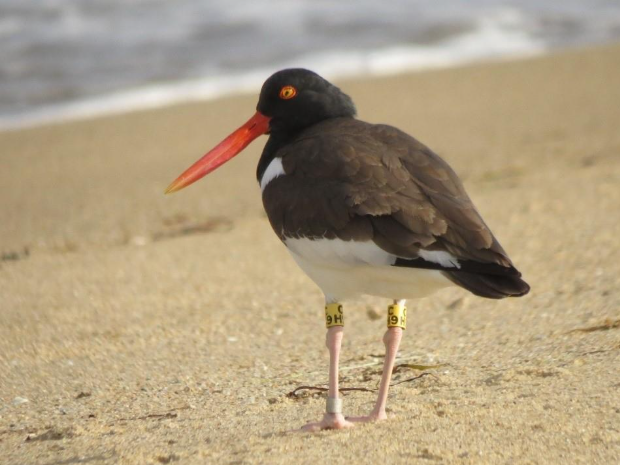
Photo by Francesca Zern
Yellow CH9- 2025 was CH9’s first official breeding season with its unbanded mate. They lost their first nesting attempt to storm surge but were able to fledge one chick on their second attempt! CH9 was banded as a chick on Coatue, Nantucket in 2020 and was first sighted on Cape Poge as a juvenile in 2023, likely scoping out future nesting habitat. Like many of our oystercatchers, it overwinters in Cedar Key, FL.
Yellow CCT- In 2021, CCT was banded as a chick on Coskata-Coatue. It is now 4 years old. This marks its first breeding year. Together, with its unbanded mate it was able to fledge 2 chicks on Leland Beach after loosing their first nest to storm overwash! CCT overwinters in Cedar Key, FL.
Yellow CE9- Banded as a chick on the Haulover, Nantucket in 2019, CE9 is 6 years old. It had its first recorded nesting at just three years old on Nantucket in 2022. It spent several breeding seasons on Nantucket before making its way to the Vineyard in 2025. CE9 nested on Cape Poge this season but unfortunately was not able to raise any chicks. All three of its nesting attempts fell prey to skunks. CE9 overwinters in Citrus, FL.
Thanks to Sean Murphy, Karen Beattie, Danielle O’Dell, Grace Bell, Libby Buck, and Liz Olsen for providing the histories of oystercatcher banding on the islands.

